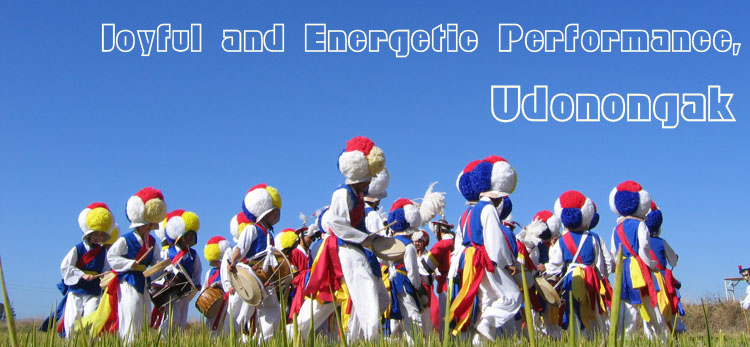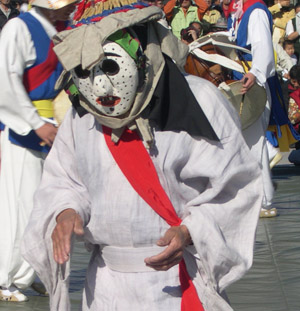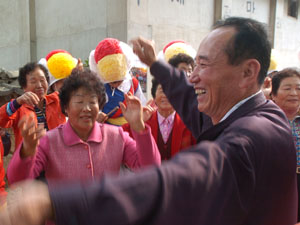우도 농악

By Gim Ye-seul, Student Editor
Musical taste of Koreans has been changing toward a Westernized one and now most Koreans are fond of hearing Western music or Korean pop songs. It is not easy to hear traditional Korean music in public places these days. We have to visit some places, like a café which sells traditional tea, in order to listen to traditional Korean music. Even though some people say traditional Korean music, like Nongak (folk music with drumming, singing and dancing), is an old-fashioned style, sometimes it makes this reporter feel full of energy through its rhythmical beats and players’ dynamic activities. Our ancestors used to enjoy this type of music as part of farm work and to pray for their villages’ safety and health by playing Nongak, which is also called Pungmul. The style of Nongak varies in different localities, and particularly Nongak in Jeolla province is divided into Jwadonongak (nongak of the left area) in the mountainous regions and Udonongak (nongak of the right area) in the plains regions of the Eastern part. Let’s know the artistic and spiritual value of our traditional music and dance, focusing on Udonongak.
The Characteristics of Udonongak

Udonongak, which was designated as Intangible Culture Property 17 in 1987, has succeeded to the tradition of Yeongmujangnongak, performed in the Southwestern area of Jeolla province, such as Yeonggwang, Mujang (Gochang), Jangseong, and Hampyeong. Udonongak is famous for individual players such as Buponori (a spinning hat dance) and Janggunori (an hourglass drum play) and Jabsaek (men wearing wooden masks), which is the best feature of Udonongak.
Gut (an exorcism rite) is the central element of Udonongak, which consists of 11 kinds of guts from Mungut to Deadangsangut. Mungut is the first ceremony symbolizing the creation of heaven and earth. Our ancestors thought that fortune and misfortune comes from heaven via a mun (gate). After Mungut, Dangsangut, Saemgut, Deuldangsangut, Madanggut, Seongjugut, Bueokgut, Jangdokgut and Cheolryonggut follows in order to pray the welfare, fecundity, good harvest and harmony of a village.
After playing those guts, the Nongak band performs Korean percussion instruments and plays diverse entertainment including songs and dances to the command of the leading instrument Sangshwe (a first small gong-player) in charge of bupo, jangdan (rhythm) and story telling. This gut is called Pangut, which is very suitable to make people getting together and generally continues until late at night.
Japsaek has a very important role in Pangut. Japseak is also the best feature of Udonongak. The motley crowd following the Nongak band plays a drama wearing a variety of wooden masks. Japseak is composed of 10 players (Daeposu, Yangban, Halmi, Chambong, Joriseung, Birisoe, Hongjeuksam, Kaksi, Jwachang and Uchang), and each character represents a certain group of people and has an important role in the play. Daeposu (a large-gunman character) leads the whole Japseak. The main story of the play describes the troubles of Daeposu who is described as a man who solves social problems. That means he acts as a guardian of justice in society. Japseak is the most interesting part of Udonongak, in that dramatic elements like Japseak with humor and wit have almost entirely disappeared in other Nongak bands in Jeollado. It moves people to sympathize with the emotions of actors through their words and gestures.
Enjoying Udonongak as a Stage Performance
Last March 28, this reporter visited Yeonggwang, which is a representative region where Udonongak has been handed down from generation to generation, to cover Udonongak. It was performed by the

Udonongak Preservation Group at the Yeonggwang Hansori Festival for the purpose of celebrating the foundation of Yeonggwang’s Artists Union. When I arrived at the front yard of the building of the Preservation Group of Udonongak located in the
About an hour later, this reporter interviewed Choi Eun-me, who is a leader of Kkwaengwari (gong) players, in the building. She said, “Today we are going to play Pangut, which is the most suitable for stage performance within a limited time.” After talking about the features of Udonongak such as Japseak and Jjakdeureum (couple-hitting between two small gong players or a small gong player and an hourglass drum player), we had to go outside of the building because she had a rehearsal on the outdoor stage.
When I went outside to watch the Udonongak performance, I could hear the sound of a Buk (drum). I thought that the Buk sound was similar to the sound of a human’s heartbeat, and this reporter felt brimming with energy whenever I heard its sound. Many players already practiced with their percussion and wind instruments including Janggu, Jing (large gong), Kkwaengwari and Napal (bugle) that were familiar to me because I had seen them before. Napal is shaped like a horn and was the most interesting and its sound was similar to a boat whistle. It is generally used to announce it is time to start a Nongak performance. On the stage, people were acting various individual plays. I could understand why Udonongak is known for its individual play. It was a gorgeous play not only listening to players’ splendid technique, but also a variety of rhythms including wit. I asked a Sogo (tabor) player who looked so happy, “Isn’t it hard to play the Sogo?” He answered, “Of course, it isn’t hard. Sogo is a part of my life. Actually I had had a hard time when I started to play the Sogo at first. But now, the more I understand Nongak, the more I become interested in it. Moreover, I can make good friends through the Preservation Group activities.”
When the setting sun gilded the sky, the Udonongak performance started with a traditional ritual served by members of the Nongak band praying their hopes to god. One woman read a prayer loudly. After the ritual service, I could hear the cheerful sounds of various musical instruments immediately. As the performance came to an to end, many people got into the rhythm of Udonongak and enjoyed it together. I felt a hot fever in spite of the chilly weather of the early spring and thought that Pungmul seemed to be the best measure to gather people’s minds. People could get along with players of instruments. While they were absorbed in the performance, they became closer and relieved their stress by enjoying its energetic rhythm. The performance continued to be played until late at night. I really wanted to join the villagers and players and to have fun after finishing the performance. I, however, had to go back to Gwangju because of the lateness of the hour. Udonongak at the festival was very exciting and I had a deeper understanding of it. However, it was a great pity that I could not see the Japseak play. I decided to come to Yeonggwang again to see all the part of Udonongak, which will be performed at the Harvest Moon festival, and it would be an unforgettable memory for me.
Discovering Our Valuable Culture
Nongak, or Pungmul has changed into the type of stage performance restricted by time. Many successors of Pungmul have insisted that the original style of Nongak is not proper in contemporary society because sometimes it continues till early the next morning. While the attractions of Pungmul may be difficult define, they are clearly players’ improvisation like jazz and spectators’ cooperative participation on the spot. Though these features are disappearing due to the popularity of commercialized cultural contents these days, Pungmul has its own high and cultural value in our modern society. Fortunately, some people want to preserve our original cultural heritage like the Udonongak Preservation Group’s members. They organized the Preservation Group in order to develop Udonongak in 1994 and have also handed down Udonongak to other residents of the region and many universities’ students. We can meet many people who try to preserve and develop traditional Korean culture like Udonongak nearby. It is time to discover our ancestors’ wisdom hidden in our cultural properties.

